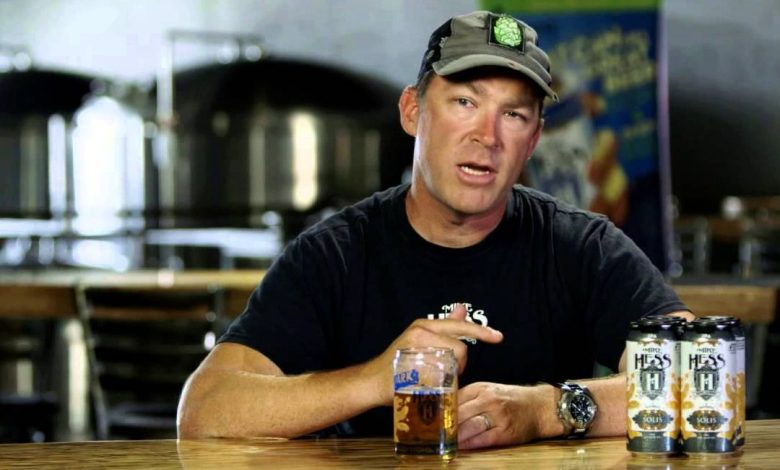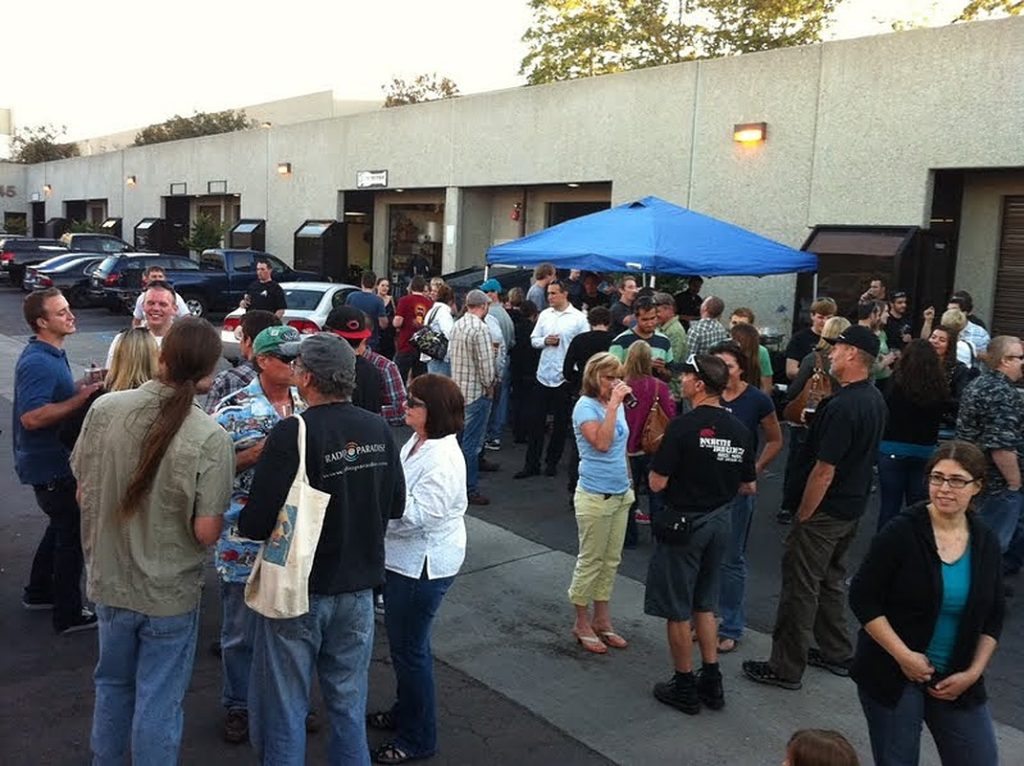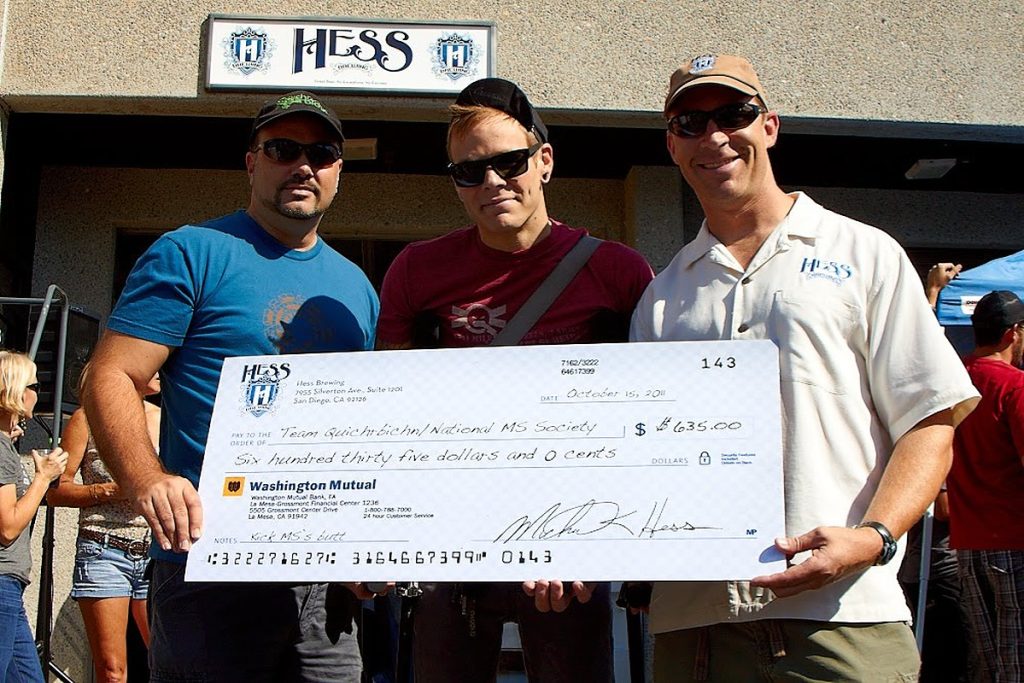
Last week we published part one of a two-part Q&A with Mike Hess, the owner of Mike Hess Brewing, following the closure of the company’s original production facility in Miramar. Hess and his team operated that spot for more than a decade, establishing themselves and making a slew of good memories. The latter are the focus of part two of our sit-down with Hess, who reflects on those memories while recalling what San Diego and the Miramar area were like when his company debuted back in 2010.
What were the early days in Miramar like?
The early days were super fun. My wife Lynda would bring the kids—who were two, four and six when we started the brewery—out often and they would have a fun time climbing into the brewery or we would sit on the floor and read books. But it was also a hell of a lot of work, and it took up all of the free time that I had outside of my regular job. We opened the nano-brewery because we wanted to see what it was like to work in the industry and see if it was fun to work in it as it was to observe it and be a consumer within it. We learned so much and we were also able to share so much of what we learned with such a large community. For example at the Craft Brewers Conference each year, there wasn’t a day or almost literally an hour that went by that somebody didn’t recognize me, Lynda or my brother Greg in their branded gear and come up to say, “Hey, we read your blog and we were able to open our brewery because you gave us the inside fast track.” It was very gratifying to know that we provided the nudge and the insight to allow so many people to follow their entrepreneurial dream.
Friday Afternoon Club (FAC) was always a super-fun time. I was always nervous that each one of them would be the one when nobody showed up, but that never happened. We were always packed and had such a fun time having people hanging out in the parking lot listening to live music and enjoying an experience that seemed very reminiscent of the good ol’ college days, drinking out of plastic cups, jamming to a band and hanging out with friends. Of course, we later learned that the ABC (California Department of Alcoholic Beverage Control) would frown on such activity, but we were ignorant of the law and that worked to our advantage because we were able to build up a regular event, one which led to the creation of The Unofficial Wednesday Afternoon Club, a group of regulars who met at our tasting room independently of any promotion by the brewery. And it was this very loyal and regular fan base that led us to do what we did, which was build out our future North Park brewery and keep building the brand.
Some of my fondest memories of that first year out in Miramar include the FAC that fell on my birthday. Everybody sang and there was a cake. Another was a Saint Patrick’s Day event where we asked everybody to bring pop-up tents because it was raining and we still had 100 people show up and probably 15 canopy tents as well as a legendary local blues artist who played solo under a tent. The first time we broke $1,000 in nightly sales was memorable, partly because everybody was out of town, so we had two people with no experience behind the bar working. That was hilarious. We had help getting through numerous brew days, often from people who went on to successful brewing careers at other breweries. In fact, Mike Hess Brewing had a hand in launching some of the careers in the San Diego brewing world and beyond.
And people should remember that back in 2010 when we got licensed, we were operating under a whole different set of rules than the way things are now. For example, TVs were not allowed in brewery tasting rooms, nor chairs…chairs! Nor were we allowed to pour full pints of beer, just tasters. Just opening a brewery back then was a big deal. There were only 32 breweries in San Diego, which seemed like a lot back then, but now we see it was just the beginning of the hockey-stick growth curve, and the City of San Diego was doing everything it could to facilitate and encourage breweries to open. For example, I remember that Business Development Manager Russ Gibbon came to our FAC to talk to me about our idea of expanding to North Park and heard my pitch on converting an old bookstore into a brewery when it was not explicitly permissible, yet it was permissible to allow a bakery in there and he pushed forward the agenda within the City to get permission to put in a brewery. I remember driving downtown with my licensing paperwork in-hand in need of a City signature, and he came down from his office, picked it up from me on a street corner while I sat behind the wheel, ran it upstairs to get the signature, then brought it back down to me. It was a unique time in the history of brewing in San Diego and we were glad to be a part of it.

How did you build up the Miramar location before expanding to North Park?
I think by the end of the first year, if not sooner, we had already blown out the wall that connected our suite to the one next door, and a few years later, we punched through the back wall into the third suite, although we never realized the potential of that area. At one point in time, we owned a 10-barrel system and fermenters, and had it on the ground in that back suite, but after running the numbers of the cost of installation, it became evident that small system would never pay for itself. We ended up selling it to AleSmith.
I would think that the biggest advancement in our beer in the Miramar days was obtaining an unused vessel from Coronado Brewing that I was able to convert into a bright tank. It was in sad shape. The inside was pockmarked and there was a manway but no door. But after many, many hours of Chris Minnema (our current Director of Finance) running a flap wheel inside to polish the stainless, and having a local fabricator (the same one that fashioned our original brewery kettles) make a door, and getting a gasket, we were able to carbonate beers three barrels at a time. From time to time, we’d borrow a Zahm volume meter from AleSmith to make sure our beers were properly carbonated. That was a huge game-changer for us. At the same time, we also had expanded our fermenter fleet and were blending batches so that we not only had much better batch-to-batch consistency but also properly carbonated beers.
What roles did Miramar take after you moved your headquarters to North Park?
Miramar had a very loyal fan following, not only folks who worked there in the industrial park but also people who drove up and down Miramar Road because it was on their way to or from work or they were just fans of ours and didn’t mind the trek because we always had that unique feel of just hanging out in Mike’s garage with your friends. At one point we actually considered branding it that way. But honestly, once we opened up North Park, and certainly after we opened up our third location in Ocean Beach, Miramar was more nostalgic than a net-positive on the business. We rarely brewed there, only enough to keep the license valid, and we still had FACs, but the Miramar area changed significantly over those next half-dozen years, going from essentially just two breweries—us and AleSmith—to more than a dozen in a very compressed area between the 15 and 5 freeways. Eventually, it made no financial sense to sink the kind of capital into that location that we saw other breweries investing to dress out their tasting rooms. The number of taps in the Miramar area pouring independent craft beer grew far faster than the number of mouths that would come to the area to help those breweries drain their tanks. All of this led us to the decision to close our original location down.

What were your feelings as you exited the Miramar facility?
I look back at our time in the Miramar facility with great fondness and I’m not sad or bummed about it at all. The Miramar facility did what it was intended to do; it was an incubator for proof-testing an idea. And it answered some questions for us. We wondered if anybody would not only pay for our beer, but pay for it again and again. We wondered if brewing was an industry we wanted to work in, be successful in and find purpose and meaning in. We wondered if we could run a business that would be fulfilling for both us and our teammates. And I think we found the answer to be a resounding “yes.” Miramar helped us shape our model, which is really gathering people together over great beer and great causes.
I think that we, our team and our brand have shown that we are true to our core for our purpose, that our words are more than just words, and that we love having people out to enjoy the facilities that we have built, the beer that we brew and the experiences that the whole package offers. And the roots of this all go back to our early days in Miramar when we were doing what few others were doing at the time.

